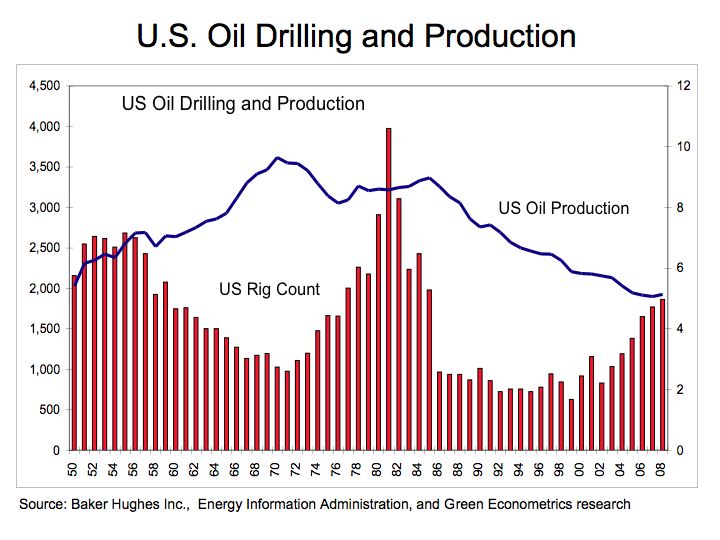”DRILL BABY DRILL” – NO INVEST INTO ENERGY TECHNOLOGY
Using the latest data from the Energy Information Administration (EIA) , oil production remains significantly below historical levels achieved in ‘70’s and ‘80’s. The peak production in 1970 has not been replicated despite significant expansion of drilling activity during the 1980’s.
Oil Drilling and Production
Figure 1 Oil Drilling and Production 
Figure 1 illustrates US historical oil production, as measured by the Energy Information Administration in U.S. Crude Oil Field Production (Thousand Barrels per Day) that dates back to 1920 juxtaposed against U.S. rig count, as measured by Bakers Hughes. The chart suggests that during the first energy shock to hit the US and the world, drilling activity expanded dramatically. By 1981, weekly North American oil rig count reached a high of 4,530 oil rigs in 1981.
U.S. Crude Oil Field Production reached a peak of 9.6 million barrels per day in 1970. In 1981, the height of US oil drilling, oil production was 8.57 million barrels per day. By 2002, U.S. Crude Oil Field Production was 5.74 million barrels per day. Over the last six years oil production declined 10.7% while over this same period, drilling activity as measured by Baker Hughes’ North American Rigs Running weekly rig count, increased 125%.
The decline in U.S. oil production is quite disturbing. During the last decade, a host of new technologies were introduced to help facilitate oil production. Companies such as Dawson Geophysical Co. (DWSN) that enhanced the market for energy exploration by providing seismic data acquisition services. Dawson Geophysical acquires and processes data using 2-D and 3-D seismic imaging technology to assess the potential of hydrocarbon sources below the earth’s surface.
Companies such as W-H Energy Services Inc. that was recently acquired by Smith International, Inc (SII) , offer an array of drilling services such as horizontal and directional drilling for onshore and offshore oil drilling, and 3-demensional rotary steering drilling systems. Smith Int’l is growing revenues at over 19% annually and Dawson’s revenues are growing 53%. With these oil drilling and energy exploration technologies growing at double rates, and drilling activity expanding at 14%, why is oil production falling?
With the rancor of “drill baby drill’ heard as call to solve the energy crisis, energy technologies such as solar and wind energy solutions deserve greater emphasis. Oil will eventually run out. There is a finite amount of oil in the ground. The Tar Sands will not solve the problem. According to Alberta Energy, sand oil production was 966,000 barrels per day (bbl/d) in 2005 and is expected to reach 3 million bbl/d by 2020. Tar sands would only contribute 3.5% towards our current oil consumption of 84.5 million barrels per day.
The bottom line is that our dependence on oil leaves our economy vulnerable. Energy is the catalyst that enables economic development. The longer we are dependent on importing oil from countries hostile to civilized existence, the more tenuous grows the environment. We need to conserve existing energy use and invest into energy technologies that foster the development of alternative energies, thereby, limiting our dependence on oil period.
renewable energy blogs
This is a topic that’s close to my heart…
Thank you! Exactly where are your contact details though?